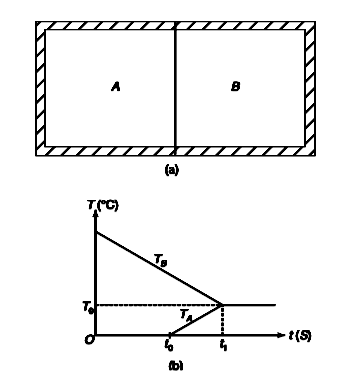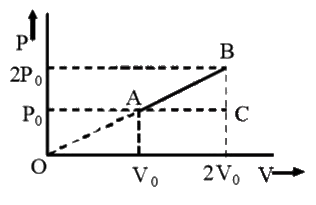Objects A and B that are initially separated from each other and well isolated from their surroundings are then brought into thermal contact. Initially TA=0∘C and TB=100∘C . The specific heat of A is less than the specific heat of B. After some time, the system comes to an equilibrium state. the final temperatures are:
_E01_036_Q01.png) Solution in Gujrati
Solution in Gujrati
TA=TB>50∘C
TA>TB>50∘C
TA=TB<50∘C
TB>TA>50∘C
The correct Answer is:A
At equilibrium TA=TB
Topper's Solved these Questions
- GEOMETRICAL OPTICSBOOK - ALLEN CHAPTER - GEOMETRICAL OPTICSEXERCISE - EXERCISE -02
82 Videos
- GEOMETRICAL OPTICSBOOK - ALLEN CHAPTER - GEOMETRICAL OPTICSEXERCISE - EXERCISE -03
11 Videos
- GEOMETRICAL OPTICSBOOK - ALLEN CHAPTER - GEOMETRICAL OPTICSEXERCISE - SOME WORKED OUT EXAMPLES
84 Videos
- CURRENT ELECTRICITYBOOK - ALLEN CHAPTER - CURRENT ELECTRICITYEXERCISE - EX.II
66 Videos
- GRAVITATIONBOOK - ALLEN CHAPTER - GRAVITATIONEXERCISE - EXERCISE 4
9 Videos
Similar Questions
A triangular plate has two cavities , one square and one rectangular as shown in figure . The plate is heated.
_E01_066_Q01.png)
View SolutionThree liquids A,B and C having same specific heat and mass m , 2m and 3 m have temperature 20∘C,40∘C and 60∘C respectively. Temperature of the mixture when:
Column-IColumn-II(A)A and B are mixed(p)33∘C(B)A and C are mixed(q)52∘C(C)B and C are mixed(r)50∘C(D)A,B and C all three are mixed(s)46∘C(t)None
View SolutionIn an 20 m deep lake, the bottom is at a constant temperature of 4∘C. The air temperature is constant at −10∘C. The thermal conductivity of ice in 4 times that water. Neglecting the expansion of water on freezing, the maximum thickness of ice will be
View SolutionIn the Bohr's model of hy drogen atom, the electron moves around the nucleus in a circular orbit of radius 5×10−11m. Its time period is 1.5×10−16s. The current associated with the electron motion is:-
View SolutionAssertion : The difference in the value of acceleration due to gravity at pole and equator is proportional to square of angular velocity of earth.
Reason : the value of acceleration due to gravity is minimum at the equator and maximum at the pole.
View SolutionA solid sphere of radius 'R' density rho and specific heat 'S' initially at temperature T_(0) Kelvin is suspended in a surrounding at temperature 0K. Then the time required to decrease the temperature of the sphere from T_(0) to (T_(0))/(2) kelvin is (Assume sphere behaves like a black body)
View SolutionA well insulated box has two compartments A and B with a conducting wall between them. 100 g of ice at 0∘C is kept in compartment A and 100 g of water at 100∘C is kept in B at time t = 0. The temperature of the two parts A and B is monitored and a graph is plotted for temperatures TA and TB versus time (t) [Fig. (b)]. Assume that temperature inside each compartment remains uniform.

(a) Is it correct to assert that the conducting wall conducts heat at a uniform rate, irrespective of the temperature difference between A and B?
(b) Find the value of time t1 and temperature T0 shown in the graph, if it is known that t0=200s.
Specific heat of ice =0.5calg−1.∘C−1
Specific heat of water =1.0calg−1.∘C−1
Latent heat of fusion of ice =80calg−1
View SolutionThe specific heat of a substance at temperature at t∘c is s=at2+bt+c. Calculate the amount of heat required to raise the temperature of m g of the substance from 0∘C to t∘0C
View Solution'If a system A is in thermal equilibrium with B and B is in thermal equilibrium with C , then A and C are in thermal equilibrium with each other.'' This is a statement of
View SolutionThree metallic spheres A,B and C have their masses in the ratio 1:2:3, specific heat capacities in the ratio 6:3:4. When the initial temperature of the spheres are measrued in Celsius scale, the ratio of their temperature is found to be 1:2:3. Initially the two spheres A and B are brought into contact. when equilibrium temperature is attained, sphere B is brought into contact with 'C'. Determine the ratio of the final temperatures of A,B and C as measured in Celsius scale.
View Solutionवस्तु A व वस्तु B में से वस्तु A की विशिष्ट ऊष्मा वस्तु B की तुलना में कम है , तो -
View SolutionOne mole of monatomic gas is brought from state A to state B. The initial temperature at A is T_(0) . The temperature at B will be –
View SolutionOne mole of monatomic gas is brought from state A to state B. The initial temperature at A is T_(0) . – In the above question, heat absorbed along the path ACB is -
View SolutionOne mole of monatomic gas is brought from state A to state B. The initial temperature at A is T0. –

In question, the heat absorbed in going from A to B is -
View SolutionTwo identical systems, with heat capacity at a constant volume that varies as Cv=bT3 (where b is a constant) are thermally isolated. Initially, one system is at a temperature 100 K and the other is at 200K. The systems are then brought to thermal contact and the combined system is allowed reach thermal equilibrium. If T40=n×108 then what will be the value of n, where T0 is the final temperature in kelvin?
View SolutionIf the two systems A and B in thermal contact are in thermal equilibrium with system C separately (A and B are in thermal equilibrium), are the systems A and B in thermal equilibrium with each other?
View Solution
